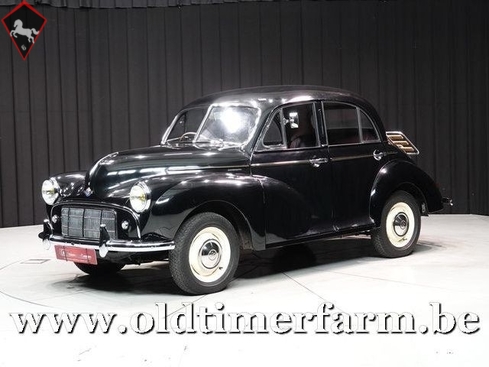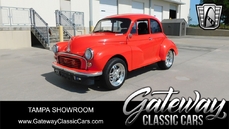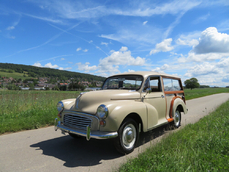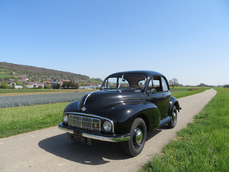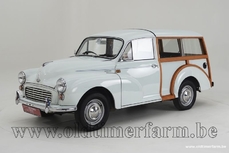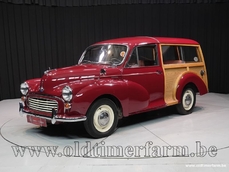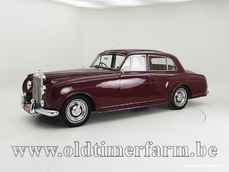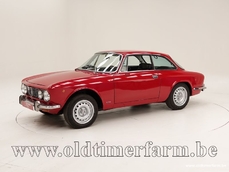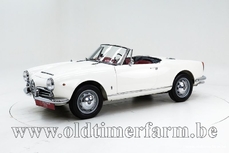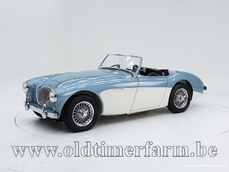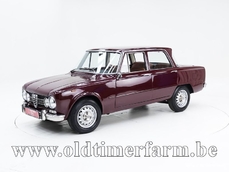Morris Minor 1952
Allgemeine Beschreibung :
Lowered price from €12.950 - €11.500 History of this special car: The car was imported in 1952 by the Austrian importer. The sign is still on the right side of the bulkhead. In 1955 the car went back to England on English license plate. When the current owner bought it, it was 'in his own words' like a chicken coop, the entire interior was tattered. The car was originally green with a green leather interior. This is therefore once, probably when it was restored in the eighties, changed to black with red leather upholstery, a much nicer combination. Current state: Over the years, the side valve engine was replaced by the more modern and much more performant head valve from a later series. Recently the interior was renewed and the brakes were overhauled, new radiator, water pump and overhauled starter engine, were fitted. New rotor springs and suspension, and numerous maintenance-sensitive parts. The track rods were not secured and the car had a lot of toe-in which caused some outside wear on the tires. Furthermore, some welding has been done on the chassis. Various parts have been chrome-plated again. The car still has its rare hardboard sky, although not 100% beautiful but a waste to replace. The trafficators work properly. Ready to drive, a piece of English history, quite rare now in 4 doors. For the real enthusiast. (from Wikipedia) Sir Alec Issigonis' concept was to combine the luxury and convenience of a good motor car at a price affordable by the working classes. The Minor was a roomy vehicle with superior cornering and handling characteristics. Internal politics inside BMC, the owner of Morris, may have led to the limited North American sales. The Minor prototype had been known as the Morris Mosquito. More than 1.3 million of the lightweight, rear-wheel drive cars were eventually produced, mainly in Cowley, Oxfordshire, becoming Britain's first million seller, and exported around the world, with many variants of the original model. Production continued in Birmingham, England until 1972 (for the commercial variants and estate only). The last Morris Minor (commercial) was assembled at Stoke, Nelson, New Zealand in 1974. The Minor has been described as typifying "Englishness", a "British icon" and a "design classic". The original Minor MM series lasted from 1948 until 1953. It included a pair of 4-seat saloons, 2-door and (from 1950) 4-door, and a convertible 4-seat Tourer. The front torsion bar suspension was shared with the larger Morris Oxford, as was the almost-unibody construction. Although the Minor was originally designed to accept a flat-4 engine, with four distinctive gaps in the engine bay to accommodate it, late in the development stage it was replaced by a 918 cc (56.0 cu in) side-valve straight-4 pretty much unchanged fron the outgoing Morris 8, and producing 27.5 hp (21 kW) and 39 lbf·ft (53 N·m) of torque. This little engine pushed the Minor to just 64 mph (103 km/h) but delivered 40 miles per imperial gallon (7.1 L/100 km; 33 mpg-US). Brakes were 4-wheel drums. Early cars had a painted section in the centre of the bumpers to cover the widening of the production car from the prototypes. This widening of 4 inches (102 mm) is also visible in the creases in the bonnet. Exports to the United States began in 1949 with the headlamps removed from within the grille surround to be mounted higher on the wings to meet local safety requirements. In 1950 a four-door version appeared, initially available only for export, and featuring from the start the headlamps faired into the wings rather than set lower down on either side of the grille. The raised headlight position became standard on all Minors in time for 1951. From the start, the Minor had semaphore-type turn indicators, and subsequent Minor versions persisted with these until 1961. An Autocar Magazine road test in 1950 reported that these were "not of the usual self-cancelling type, but incorporate[d] a time-basis return mechanism in a switch below the facia, in front of the driver". It was all too easy for a passenger hurriedly emerging from the front passenger seat to collide with and snap off a tardy indicator "flipper" that was still sticking out of the B-pillar, having not yet been safely returned by the time-basis return mechanism to its folded position. Another innovation towards the end of 1950 was a water pump (replacing a gravity dependent system) which permitted the manufacturer to offer an interior heater "as optional equipment". When production of the first series ended, just over a quarter of a million had been sold, 30% of them the convertible Tourer model. A tourer tested by the British magazine The Motor in 1950 had a top speed of 58.7 mph (94.5 km/h) and could accelerate from 0–50 mph (80 km/h) in 29.2 seconds for the 1098cc engine. However, the 918cc(56.01CID) engine did 0-60 mph in 50+ seconds. A fuel consumption of 42 miles per imperial gallon (6.7 L/100 km; 35 mpg-US) was recorded. The test car cost £382 including taxes. In 1952, the Minor line was updated with an Austin-designed 803 cc (49.0 cu in) overhead valve A-Series engine, replacing the original side-valve unit. The engine had been designed for the Minor's main competition, the Austin A30, but became available as Austin and Morris were merged into the British Motor Corporation. The new engine felt stronger, though all measurements were smaller than the old. The 52 second drive to 60 mph (97 km/h) was still calm, with 63 mph (101 km/h) as the top speed. Fuel consumption also rose to 36 miles per imperial gallon (7.8 L/100 km; 30 mpg-US). An estate version was introduced, known as the Traveller (a Morris naming tradition for estates, also seen on the Mini), along with van and pick-up versions. The Traveller featured an external structural ash (wood) frame for the rear bodywork, with two side-hinged rear doors. The frame was varnished rather than painted and a highly visible feature of the body style. Rear bodies of the van versions were all steel. The 4-seat convertible and saloon variants continued as well. The grille was modified in October 1954, and a new dashboard with a central speedometer was fitted. Almost half a million examples had been produced when the line ended in 1956. The Motor magazine tested a 4-door saloon in 1952. It reported a top speed of 62 mph (100 km/h) and acceleration from 0–50 mph (80 km/h) in 28.6 seconds. A fuel consumption of 39.3 miles per imperial gallon (7.19 L/100 km; 32.7 mpg-US) was recorded. The test car cost £631 including taxes. The car was again updated in 1956 when the engine was increased in capacity to 948 cc (57.9 cu in). The two-piece split windscreen was replaced with a curved one-piece one and the rear window was enlarged. In 1961 the semaphore-style trafficators were replaced by the flashing direction indicators, these were US-style red at the rear (using the same bulb filament as the brake lamp) and white at the front (using a second brighter filament in the parking lamp bulb) which was legal in the UK and many export markets at the time (such as New Zealand). An upmarket car based on the Minor floorpan using the larger BMC B-Series engine was sold as the Riley One-Point-Five/Wolseley 1500 beginning in 1957: versions of this Wolseley/Riley variant were also produced by BMC Australia as the Morris Major and the Austin Lancer. Specifications Bodywork Length : cm (in): 376 (148) Width : cm (in): 155 (61) Height : cm (in): 152 (60) Wheelbase : cm (in) : 218 (86) Weight: kg (lb) : 770 (1699) Mechanics. Displacement : straight four 919 cc, front-mounted Valve gear : 8 Fuel system : 1 SU carburetor Gearbox : 4-speed manual Drive wheels : rear-wheel drive Maximum power : 28 bhp at 4750 rpm Maximum torque : 53 Nm at 2500 rpm Maximum speed : 102 km/h (63 mph
http://www.oldtimerfarm.be/en/collection-cars-for-sale/4533/morris-minor-mm-four-door-saloon-52.php
1952 Morris Minor is listed verkauft on ClassicDigest in Aalter by Oldtimerfarm Dealer for €9500.
Fakten der Auto
Karosserietyp : Auto Marke : Morris Modell : Minor Hubraum : 0.0 Modelljahr : 1952 Karosstyp : Sedan Farbe : Schwarz Lage : Aalter
Verkauft
Angaben Zum Verkäufer
Verkauft
People who viewed this Morris Minor also viewed similar Morris listed at ClassicDigest
Other cars listed for sale by this dealer
über Morris
Die Geschichte von Morris Motors erstreckt sich über mehrere Jahrzehnte und umfasst die Produktion verschiedener ikonischer Modelle, die einen bedeutenden Einfluss auf die Automobilindustrie in Großbritannien hatten. Von der Gründung bis zur Integration in die British Leyland Motor Corporation (BLMC) spielte Morris eine entscheidende Rolle bei der Gestaltung der alltäglichen Fahrerlebnisse unzähliger Briten.Gründungsjahre (1912-1920er Jahre): William Morris gründete 1912 die Morris Motors Limited. Das Unternehmen produzierte zunächst erschwingliche Fahrzeuge, darunter den Morris Oxford und den Morris Cowley, die für ihre Zuverlässigkeit bekannt waren und beliebte Optionen unter der arbeitenden Bevölkerung wurden.
Zwischenkriegszeit (1930er Jahre): In den 1930er Jahren führte Morris bedeutende Modelle wie den Morris Eight ein, ein kleines Auto, das aufgrund seiner Erschwinglichkeit, Zuverlässigkeit und Benutzerfreundlichkeit weithin beliebt wurde. Auch der Morris Ten erregte in dieser Ära Aufmerksamkeit.
Nach dem Zweiten Weltkrieg (1940er-1950er Jahre): Nach dem Zweiten Weltkrieg führte Morris Modelle wie den Morris Minor von 1948 ein. Der Minor war ein revolutionäres kleines Auto mit modernen Merkmalen, großzügigem Platzangebot im Innenraum und wurde zu einem Symbol britischer Automobilgeschichte.
Expansion und Fusion (1960er Jahre): In den 1960er Jahren war Morris Teil einer Reihe von Fusionen, die die British Motor Corporation (BMC) bildeten. Modelle wie der Morris Mini, der 1959 eingeführt wurde, wurden international sensationell und zu einem Emblem britischer Konstruktions- und Ingenieurskunst.
Ära bei British Leyland (1970er Jahre): Im Jahr 1968 fusionierte BMC mit Leyland Motors zur British Leyland Motor Corporation (BLMC). Morris produzierte weiterhin mehrere Modelle, verlor aber innerhalb des größeren Konzerns zunehmend seine eigene Identität.
Wichtige Morris-Modelle:
Morris Oxford (1913)
Morris Cowley (1915)
Morris Eight (1935)
Morris Ten (1933)
Morris Minor (1948)
Morris Mini (1959)
Morris Marina (1971)
Morris Ital (1980)
Morris produzierte Fahrzeuge, die den Bedürfnissen des durchschnittlichen Briten entsprachen. Ihre Fahrzeuge galten als zuverlässig, praktisch und oft erschwinglich, was sie über viele Jahre hinweg zu einem häufigen Anblick auf den Straßen Großbritanniens machte.
Jedoch stand British Leyland Ende der 1970er und Anfang der 1980er Jahre vor finanziellen Schwierigkeiten und Qualitätsproblemen, was zu einem Verlust des Ansehens von Morris und anderen Marken unter seinem Dach führte. Die Marke Morris wurde schließlich im Zuge der Neuausrichtung von British Leyland ausgemustert, als das Unternehmen seinen Fokus verlagerte und seine Produktlinien straffte.
Trotz seines schließliches Rückgangs spielte Morris eine wichtige Rolle bei der Gestaltung der Autolandschaft in Großbritannien und hinterließ ein Erbe mit mehreren Modellen, die sich in die Erinnerungen von Generationen britischer Autofahrer eingeprägt haben.
